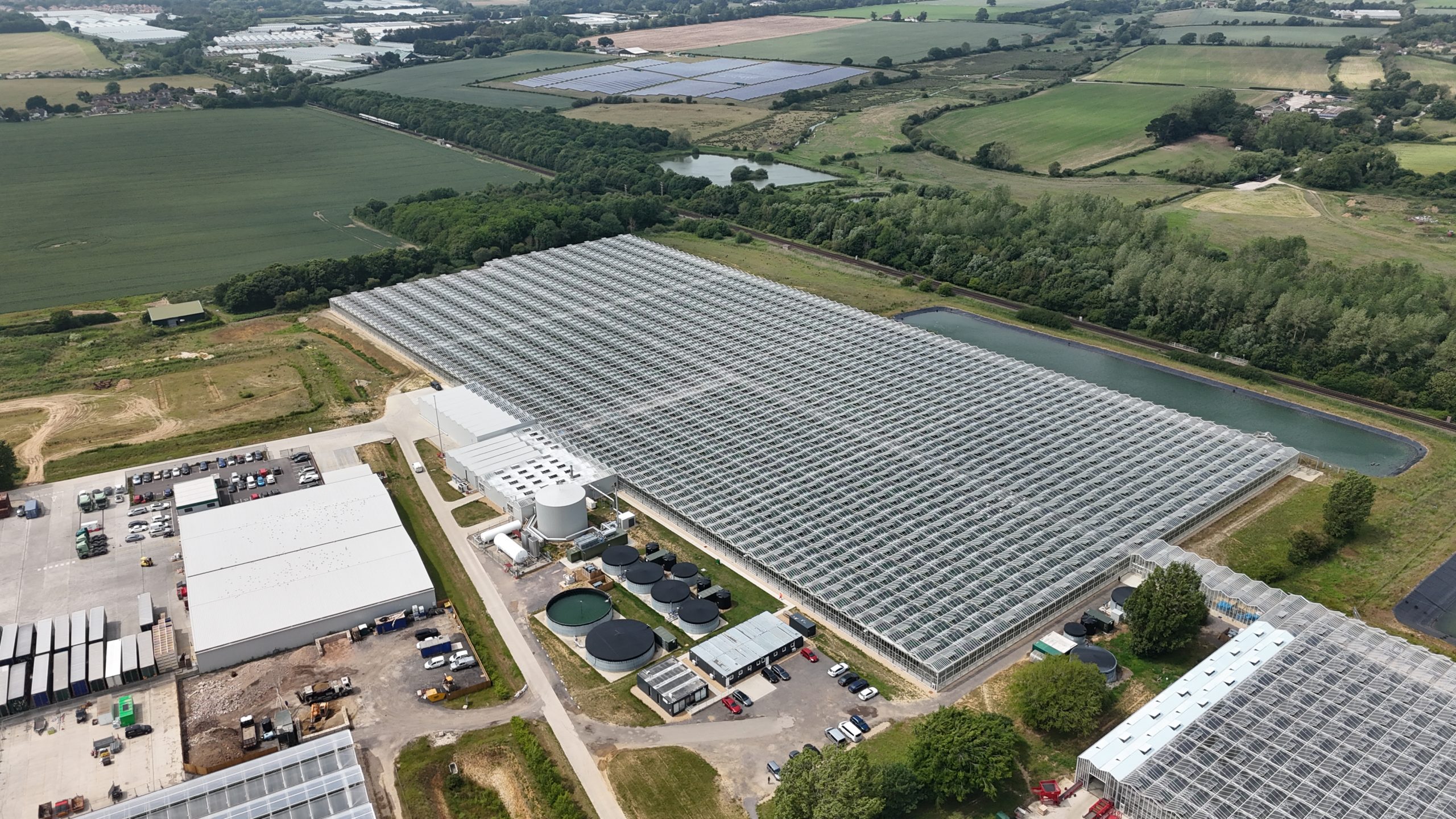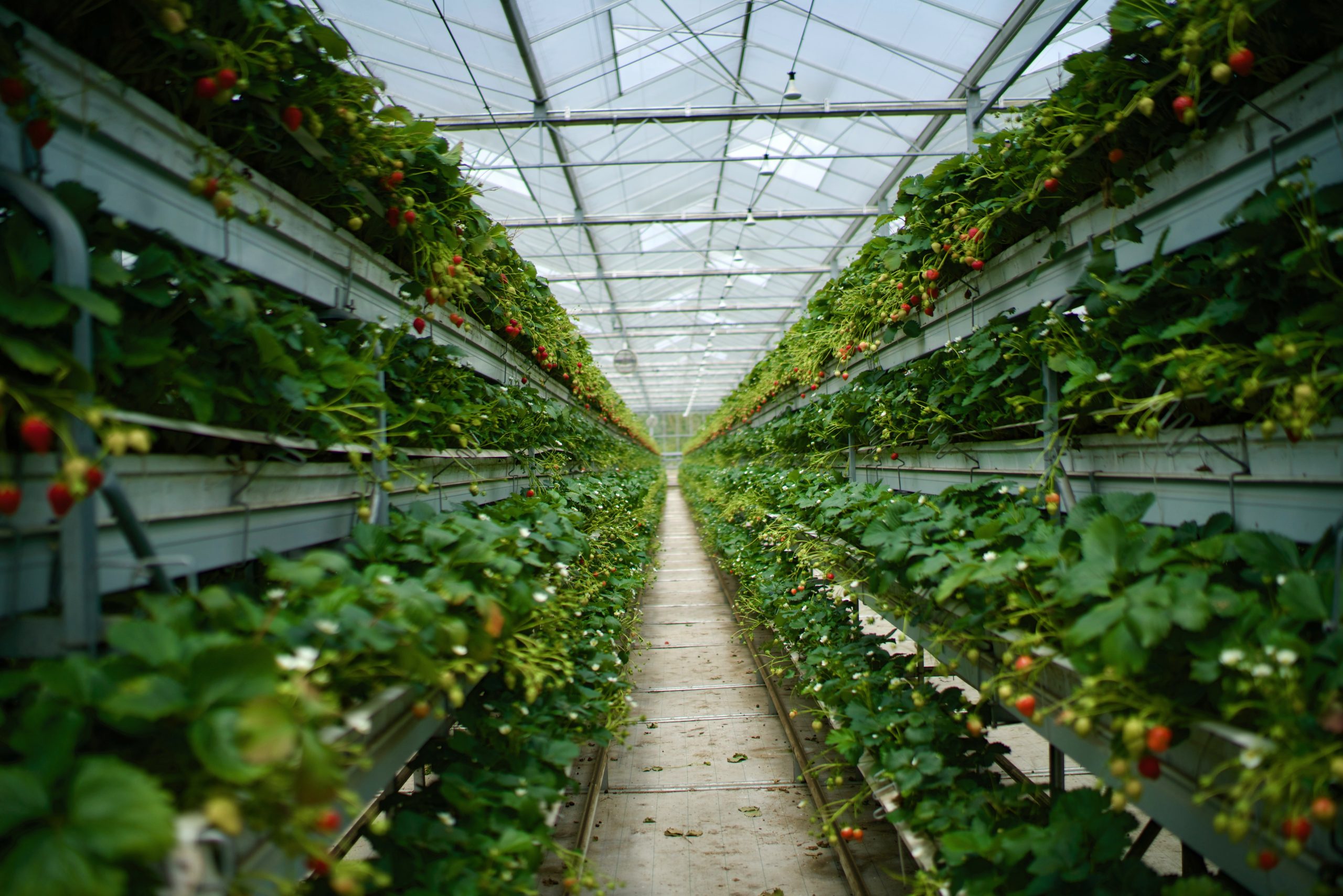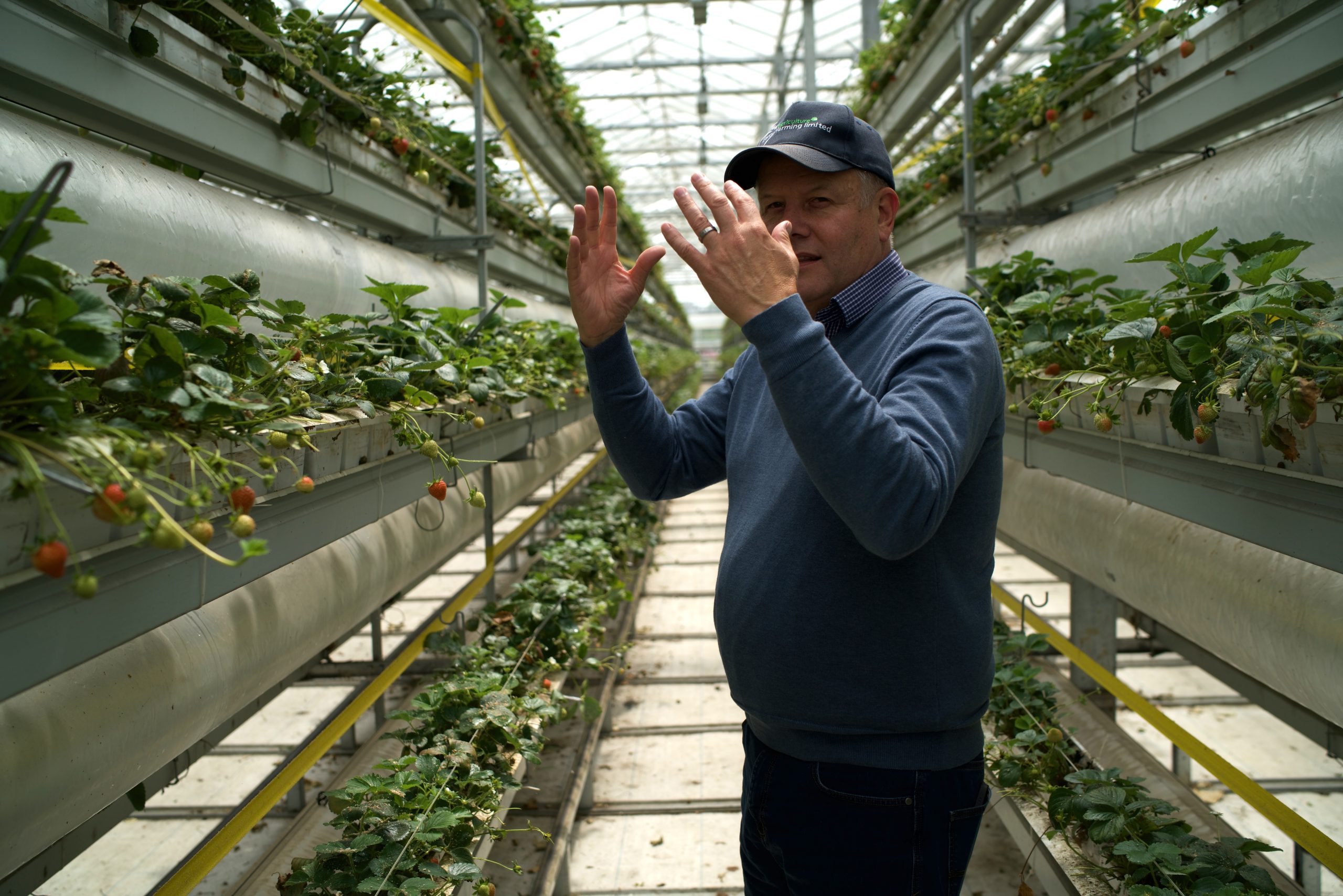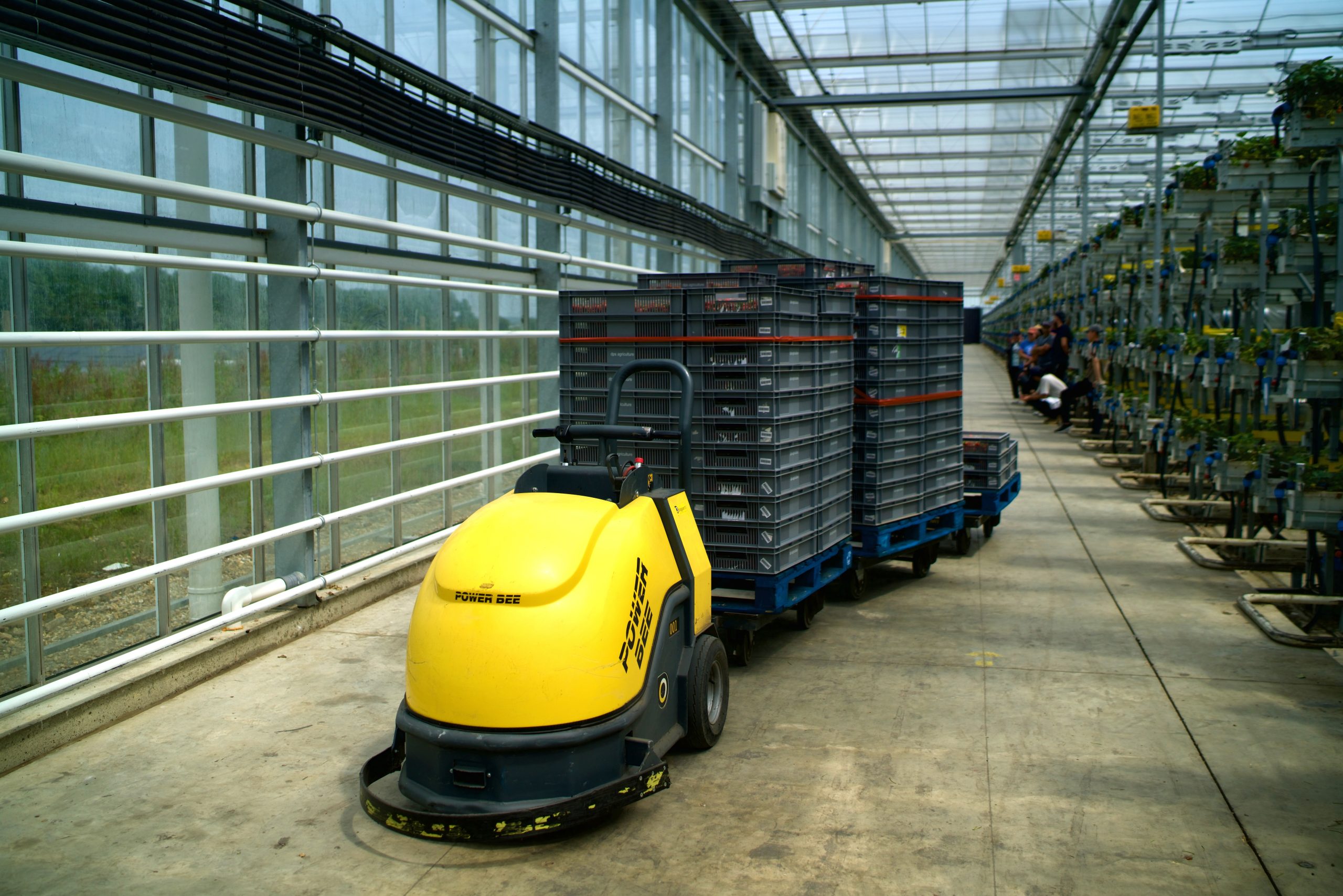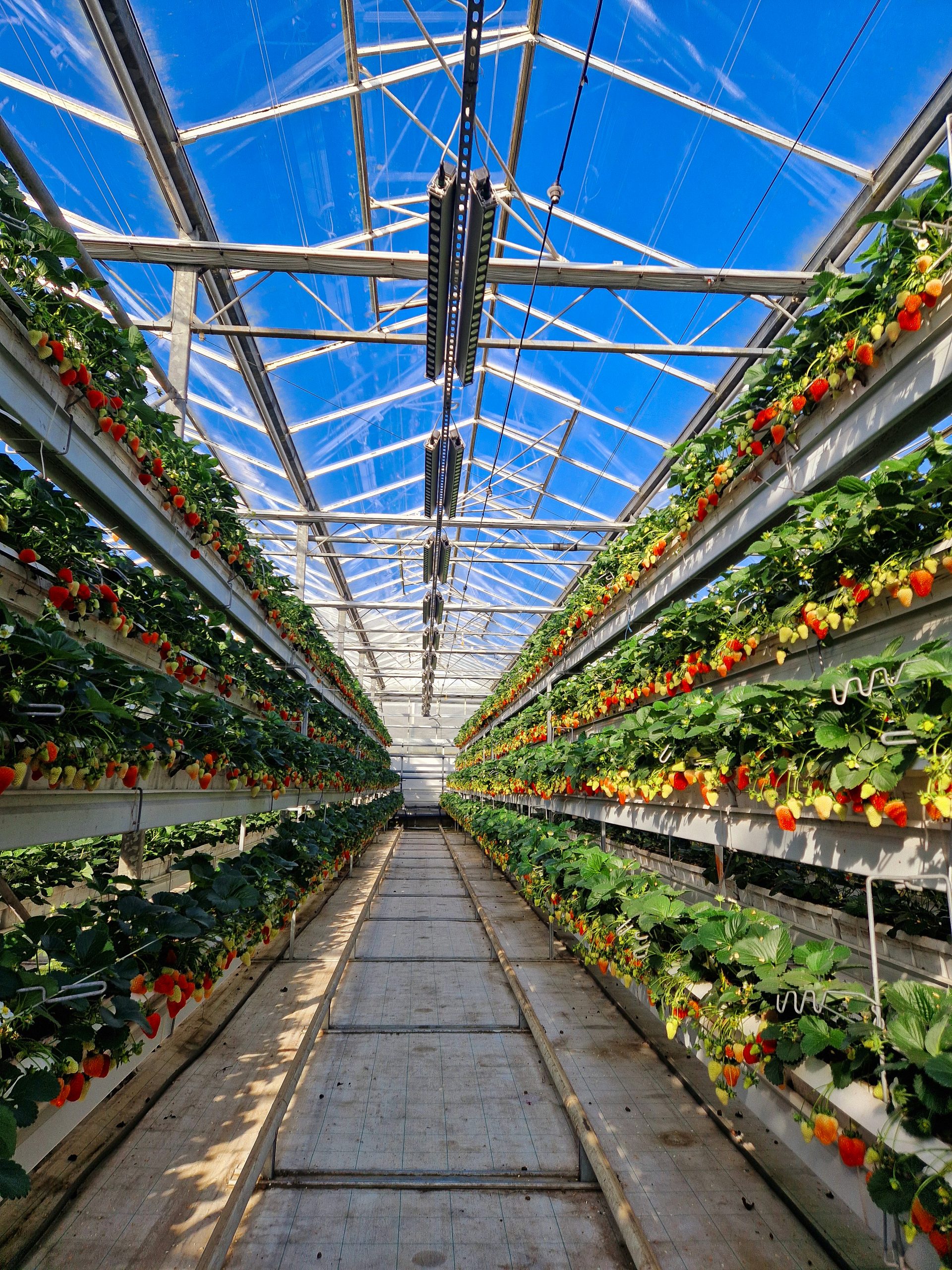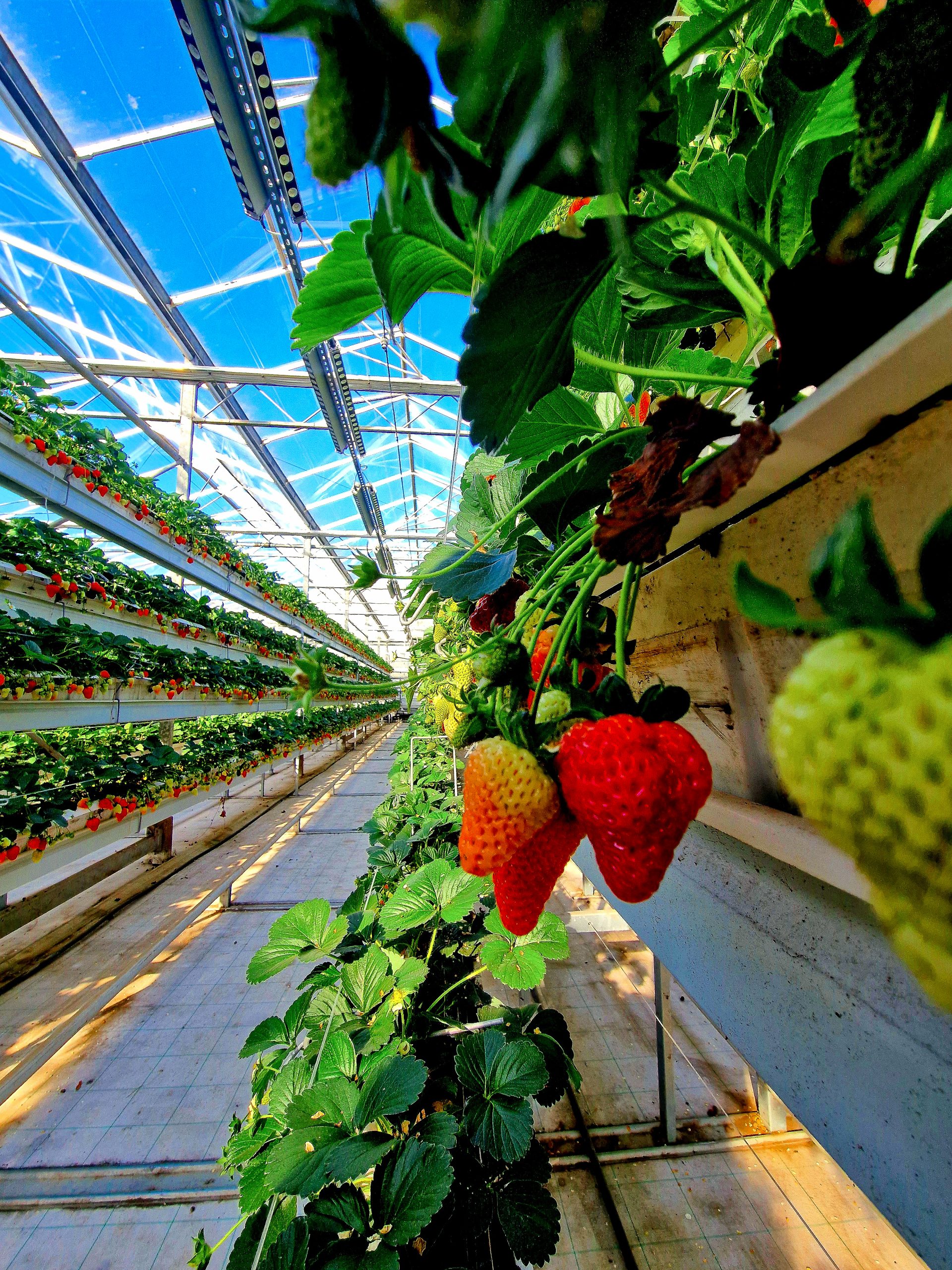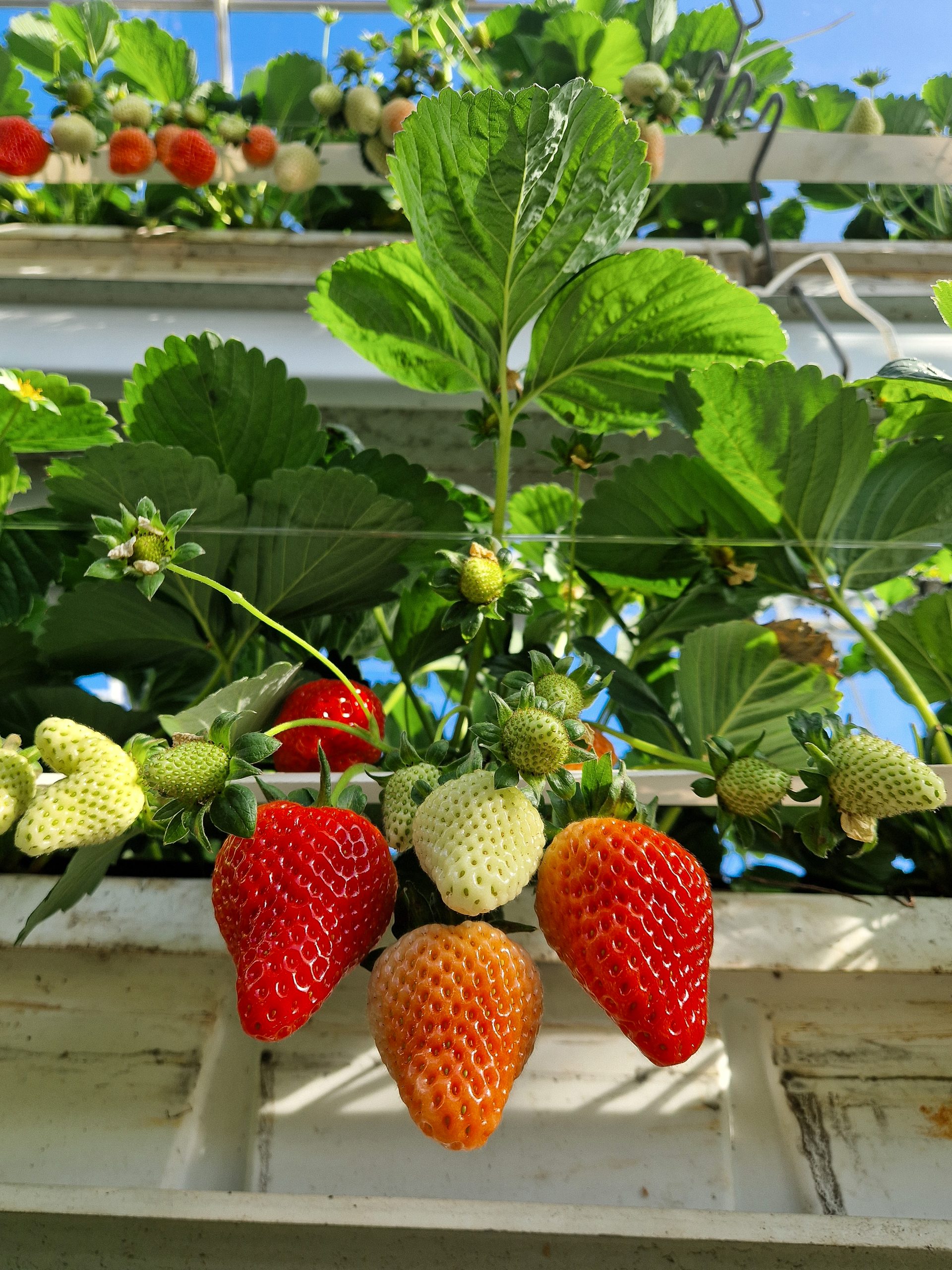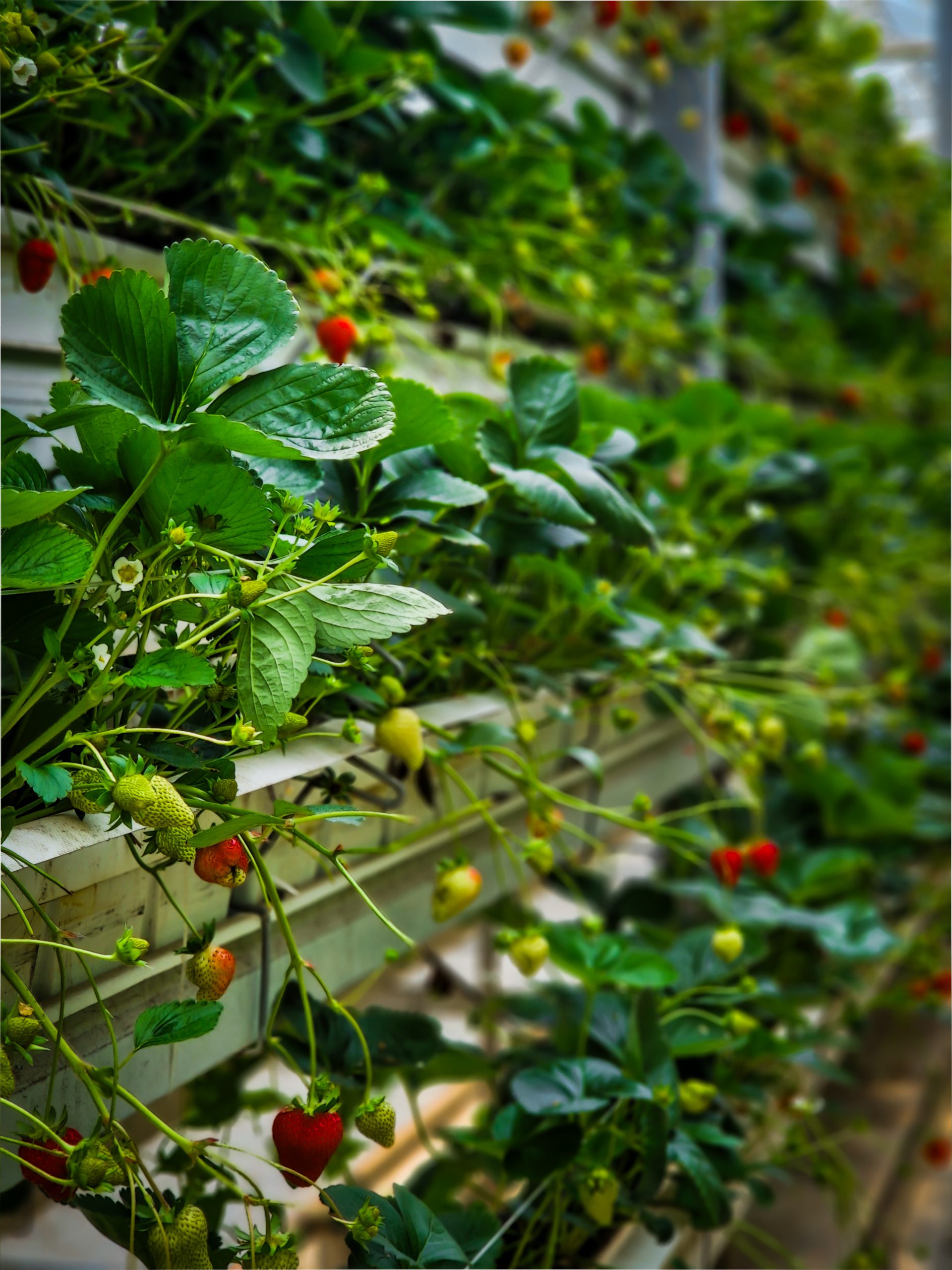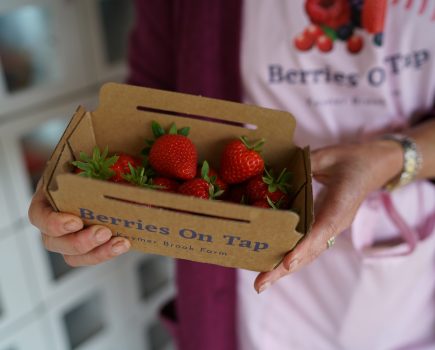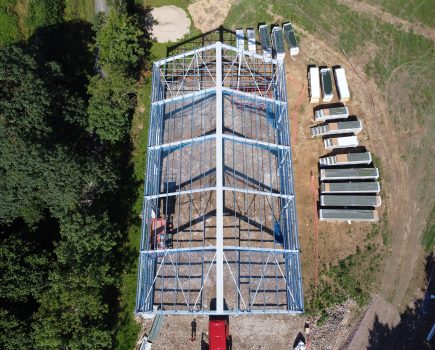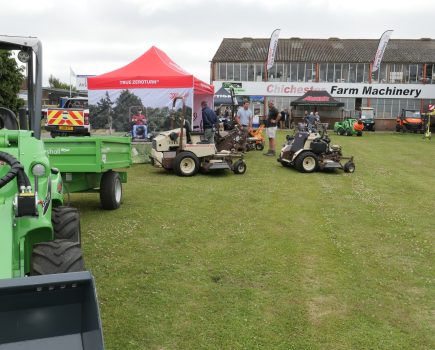This month, Nigel Akehurst visits Wicks Farm in Ford, near Arundel in West Sussex, to explore how strawberries are being grown year-round in one of the UK’s most advanced semi-vertical glasshouse systems. He met David Moore, director of agriculture with Agricultural Investments Ltd, to learn how this cutting-edge 6.5-hectare site is reshaping the future of berry production.
Turning off Ford Lane into an industrial estate, I passed a large haulage depot and followed the signs to Wicks Farm. Looming ahead was one of the largest greenhouses I’d ever seen. Parking in front of a row of new portable buildings, I made my way to their reception and office. Inside, I was welcomed by the Berry Farming Ltd team with a hot drink while I completed the biosecurity forms. David soon emerged from his office and invited me into the boardroom for a chat.
The challenge: year-round UK strawberries
Over coffee, David explained how the idea for the facility began. In 2018, one of the UK’s major retailers posed a deceptively simple question: Could they ensure a consistent supply of high-quality British strawberries during peak demand periods such as Wimbledon?
Traditional field-grown or tunnel-grown berries couldn’t guarantee the reliability required, while vertical farming – though gaining attention – was prohibitively expensive. ”Most vertical farms were producing fruit at £15 to £16 per kilo,” said David. “Retail strawberries sell for around £3 per kilo. The maths didn’t stack up.”
Instead, the team adapted a semi-vertical growing system developed by Birmingham University for use in glasshouse conditions. Their first summer crop launched in 2019. Since then, yields per square metre have tripled, water use has halved, pesticide use has dropped dramatically and carbon emissions per kilo have fallen by 67%.
“We’ve got a resilience story now,” said David, citing challenges like fluctuating light levels and climate unpredictability. “The team has really embraced a new way of thinking to make this work.”
A business built on supply chain resilience
Berry Farming is part of DPS Group, a global fruit supplier with £900 million in UK retail sales. The group also owns farms in Kent (stone fruit), Herefordshire (organic apples), and Patagonia, Chile (cherries), with further partnerships in South Africa.
David’s remit is to solve supply chain gaps, especially during tricky seasonal transitions. “The Wicks Farm glasshouse isn’t here to replace field-grown fruit,” he said. “About 90% of UK strawberries are still grown in tunnels on table tops. We’re offering a complementary model, one that can provide a supply when others can’t.”
Building a high-density system
While most UK tunnel systems grow strawberries on a single level, Wicks Farm uses a semi-vertical, multi-tiered approach. “If we’re serious about food resilience and sustainability, then the industry has to evolve,” David said. “Tabletops were a leap from soil 25 years ago. This is the next leap.” The business also benefits from fixed-term retail contracts and quarterly pricing. Thanks to the site’s sustainability credentials, they secured a five-year green loan from HSBC to help set up the facility.
Planting for consistency
The site operates on two overlapping cropping cycles that allow for near-continuous production.
The summer crop is planted in December and harvested from March through to November, while the winter crop is planted in August and harvested from October to June. This dual-cropping system ensures the infrastructure remains in use almost year-round, significantly improving efficiency and productivity.
The power behind the plants
After our chat, David took me outside to the energy centre, a sleek bank of metal structures housing a combined heat and power (CHP) plant. Using natural gas, the system generates electricity, while waste heat is stored in a 1.2 million-litre thermal tank. This hot water circulates beneath the crops, warming root zones even in the depths of winter.
Inside the glasshouse
After washing my hands and donning a hair net, we stepped inside. Rows of strawberry plants stretched into the distance in stacked, linear formations. Workers glided past on electric scissor lifts, making it feel like a set from a sci-fi film.
Despite the sun, the glasshouse wasn’t uncomfortably warm. David pointed to the laser-etched roof panels that diffuse sunlight, eliminating shadows except under vents and allowing for dense, deep cropping.
A network of over 1,300 sensors monitors temperature, humidity, CO₂ levels and vapour pressure deficit, generating more than 620,000 data points daily. Artificial intelligence (AI) tools analyse leaf colour and posture, helping optimise growing conditions. “We’re starting to listen to the plants,” David said.
Rainwater collected from the roof is sterilised using ultra-violet light and delivered via precision drippers. The site is “water neutral,” he added proudly. Nutrients are delivered several times an hour and any run-off is rebalanced and recirculated.
Summer cropping covers 50,000 square metres; winter production is currently 12,500 square metres. The strawberries are grown in expanded clay balls—80% of which are reused annually. “They look like giant Rice Krispies,” David joked, pointing to their excellent aeration and drainage properties. Pollination is managed using imported bees, housed in yellow boxes suspended above the rows.
Tailored zones and year-round technology
To maintain optimal growing conditions throughout the year, the glasshouse is divided into specific, climate-controlled zones. In the summer zones, a combination of mist cooling, natural ventilation and energy screens is used to regulate temperature and prevent overheating. Meanwhile, the winter zones rely on forced ventilation and sophisticated LED lighting systems to simulate the conditions of spring, encouraging plant growth even during the darkest months.
The LED lights, featuring red, far-red, and white wavelengths, help extend day length, enhance photosynthesis and improve plant structure. At night, thermal climate screens act like duvets, trapping heat to maintain ideal temperatures. During peak summer heat, external sprinklers and misting systems further help reduce temperatures inside the glasshouse.
Automating quality and reducing waste
Technology plays a key role in boosting productivity and plant health. One standout innovation is the semi-autonomous UV-C robot that patrols the rows at night, zapping mildew spores with ultra-violet light to help eliminate fungicide use from March onwards.
Another machine applies both pesticides and beneficial insects, natural enemies like parasitic wasps that control pests such as spider mites and whitefly. “There’s a real effort here to balance nature,” David noted.
Harvest and packing
The site produces 1,000 tonnes of summer strawberries and 250 tonnes of winter strawberries annually, alongside 250 tonnes of blackberries. All fruit is picked, cooled and packed on-site, usually within 24 hours.
Robotic trolleys move freshly picked fruit to rapid cooling tunnels (2°C), after which it’s sorted, checked and packed. Each punnet is traceable back to its picker and row. Customers include Tesco and M&S. “We’re not selling a premium product, we’re selling consistency,” David noted.
Labour, technology and recognition
As with many UK growers, labour remains a key challenge. Wicks Farm employs around 70 people, mainly seasonal workers from central Asia. Their performance is tracked via barcode systems and incentivised through structured bonuses.
“It frustrates me that the Government calls our pickers ‘unskilled’,” said David. “What they do requires dexterity, care, and consistency.”
Workers live on-site in modern accommodation. The company is also piloting apprenticeships and exploring automation. But automated strawberry picking, David smiled and noted, “has been five years away for the past 10 years.”
Looking ahead
As we returned to the office, I asked David what kept him motivated. “I love combining tech with nature, pushing the boundaries of yield and quality while staying close to the customer,” he said. “But it’s also about empowering our team.”
In the short term, the business will continue refining its climate models, varietal trials and sustainability practices. Medium term, the goal is to expand the site to its full 26-hectare planning capacity, more than tripling current production, but that is currently on hold while technical issues around National Grid capacity are resolved, something which is unlikely to happen before 2037.
The company is also laying the groundwork to license the system overseas, with strong interest from partners in northern Europe and North America. Closer to home, they’re scouting new UK sites near major cities, with the potential to co-locate with cloud data centres, capturing waste heat and CO₂ to boost sustainability.
On the horizon: new crops. Trials are already underway for hybrid seed-grown strawberries, new blackberry varieties and even niche crops like alpine strawberries and blueberries.
The workforce, too, is a long-term priority. The aim is to build a stable, year-round team supported by apprenticeships, structured seasonal contracts and responsible automation.
“We’re not building a robot farm,” David concluded. “We’re building a smarter one.”
Farm Facts
- Location: Ford, near Arundel, West Sussex
- Established: 2019 (first crop)
- Glasshouse size: 6.5 hectares (permission for 26)
- Annual production: 1,250 tonnes strawberries, 250 tonnes blackberries
- Main varieties: Four core everbearers, 10+ in trial
- Substrate: Expanded clay (80% reused)
- Water: 100% rainwater, UV-treated and recirculated
- Yield: Up to 3.5x higher per m² than conventional systems
- default
- David Moore
For more like this, sign up for the FREE South East Farmer e-newsletter here and receive all the latest farming news, reviews and insight straight to your inbox.


